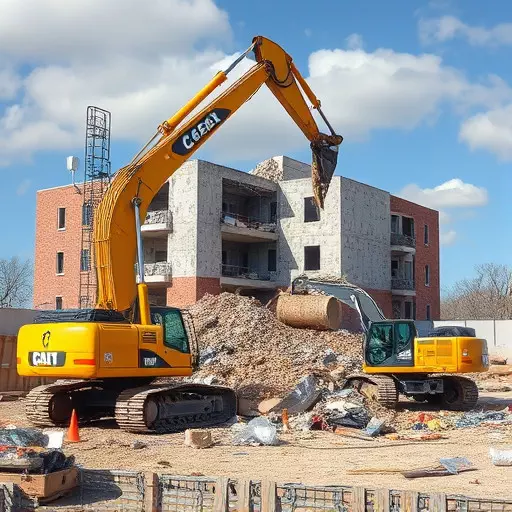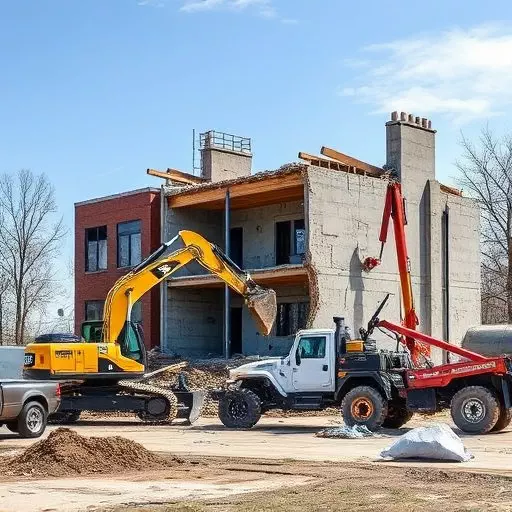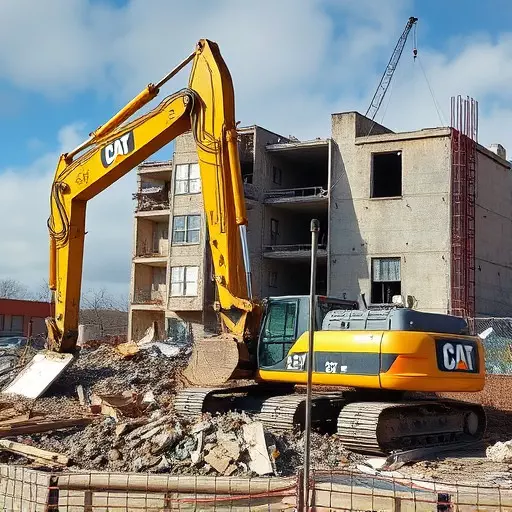Toledo's adoption of specialized demolition and recycling services and building deconstruction techniques is a leading example of sustainable urban development. By carefully disassembling structures, these methods maximize material reuse and recycling, reducing waste and conserving resources like timber, metal, and concrete. This eco-friendly approach not only minimizes the environmental impact of construction and demolition but also contributes to national efforts in waste reduction and promotes a circular economy. It sets a crucial path for cities aiming to embrace responsible building practices and drive positive change on a global scale.
In today’s quest for sustainability, end-of-life building recycling stands out as a crucial eco-friendly approach. As structures reach their lifespan, methods like building deconstruction offer a gentle alternative to traditional demolition. This article explores this evolving landscape, focusing on demolition and recycling services in Toledo as a model for sustainable practices. We delve into the potential of materials recovery from construction site demolition, its environmental impact, and its role in shaping future building practices.
- Understanding Building Deconstruction: A Gentle Approach to End-of-Life Structures
- The Role of Demolition and Recycling Services in Toledo: A Sustainable Solution
- Unlocking the Potential: Materials Recovery from Construction Site Demolition
- A Holistic View: Environmental Impact and Future Building Practices
Understanding Building Deconstruction: A Gentle Approach to End-of-Life Structures

Building deconstruction is an emerging practice that offers a more sustainable and environmentally friendly alternative to traditional construction site demolition. Unlike conventional tearing down methods, deconstruction involves carefully planning and executing the removal of materials from existing structures while maximizing their potential for reuse or recycling. This gentle approach not only reduces waste but also conserves valuable resources by salvaging building components like timber, metal, insulation, and even finishes such as flooring and fixtures.
In Toledo, demolition and recycling services play a pivotal role in promoting sustainable practices in the construction industry. Building deconstruction projects are meticulously managed to ensure that materials are sorted, processed, and redirected to appropriate facilities for repurposing or recycling. By adopting these strategies, Toledo is not only contributing to national efforts in reducing construction waste but also setting an example for eco-conscious urban development, transforming end-of-life buildings into valuable resources for future projects.
The Role of Demolition and Recycling Services in Toledo: A Sustainable Solution

In Toledo, the integration of efficient demolition and recycling services plays a pivotal role in fostering sustainability. As construction sites across the city generate substantial waste, specialized deconstruction practices have emerged as a game-changer. These services are not just about responsible disposal; they involve a meticulous process of disassembling buildings to recover valuable materials such as wood, metal, and concrete. By adopting building deconstruction methods, Toledo is ensuring that resources are repurposed rather than sent to landfills, contributing significantly to a more circular economy.
Demolition and recycling services in Toledo are revolutionizing the way construction waste is managed. They offer a sustainable solution by minimizing environmental impact, conserving natural resources, and reducing carbon emissions associated with traditional demolition methods. This proactive approach not only benefits the local ecosystem but also sets an example for other cities to follow, showcasing that responsible building practices can drive positive change on a larger scale.
Unlocking the Potential: Materials Recovery from Construction Site Demolition

The process of deconstructing and recycling buildings offers a promising path towards a more sustainable future. With the constant growth and renovation of urban landscapes, construction site demolition has become an inevitable part of progress. However, traditional disposal methods only scratch the surface of what’s possible. By utilizing advanced deconstruction techniques, materials from these sites can be recovered and reused, significantly reducing the demand for virgin resources.
In Toledo and beyond, demolition and recycling services play a pivotal role in this transformation. Building deconstruction goes beyond simple dismantling; it involves carefully planning and executing the removal of materials while maximizing their value. From steel beams to wood panels and concrete blocks, each component can be processed, cleaned, and prepared for new applications, thereby extending their lifespan and minimizing environmental impact. This innovative approach not only conserves resources but also contributes to a circular economy, where waste becomes a valuable resource.
A Holistic View: Environmental Impact and Future Building Practices

In a comprehensive analysis of end-of-life building recycling, it’s crucial to adopt a holistic view that intertwines environmental impact with future construction practices. The traditional approach to construction and demolition often results in significant environmental consequences, from resource depletion to waste generation. However, embracing sustainable strategies such as deconstruction and efficient recycling services in Toledo can mitigate these effects.
By integrating building deconstruction into the lifecycle of structures, we can minimize the ecological footprint associated with construction site demolition. This involves carefully disassembling buildings rather than just tearing them down, allowing for the recovery of valuable materials like timber, metals, and concrete. These recovered resources can be repurposed in new constructions, reducing the demand for virgin materials and fostering a circular economy. Such practices not only conserve natural resources but also lower greenhouse gas emissions, contributing to global efforts to combat climate change.


